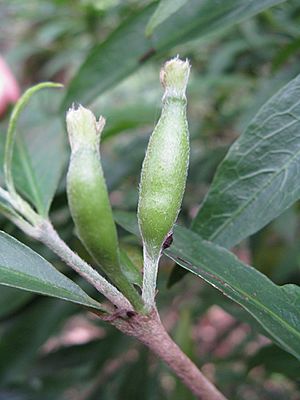Narrow-leaved gardenia facts for kids
Quick facts for kids Narrow-leaved gardeniaThin-leaved gardenia |
|
|---|---|
 |
|
| Developing fruit and leaves, Australian National Botanic Gardens, Canberra, 19 Jan 2013 by Nadia Talent | |
| Scientific classification | |
| Genus: |
Atractocarpus
|
| Species: |
chartaceus
|
| Synonyms | |
The Narrow-leaved gardenia or Thin-leaved gardenia (Atractocarpus chartaceus) is a beautiful flowering plant found in eastern Australia. It belongs to the Rubiaceae family, which also includes coffee plants! This plant grows naturally in warm, wet rainforests, especially where the soil is rich. You can find it from the Richmond River area in New South Wales all the way up to tropical Queensland. People love this plant because its flowers smell amazing, just like a regular gardenia!
Contents
What Does It Look Like?
The Narrow-leaved gardenia can be a shrub or a small tree. It usually grows up to 6 metres (20 ft) tall. The main stem, or trunk, can be about 8 cm (3 in) wide. The trunk often looks a bit bent or uneven at its base.
Bark and Branches
The bark of this plant is brownish-grey. It feels quite smooth but might have some small wrinkles or horizontal cracks. The very tips of the branches are covered in soft, light brown hairs.
Leaves
The leaves grow in pairs on opposite sides of the stem, or sometimes in a circle (called a whorl). Young leaves are very thin and long, almost like a line. As the plant gets older, the leaves become wider. They are shaped like a spearhead but wider at the tip and narrower near the stem. These adult leaves are usually 5 to 15 cm (2–6 in) long and 0.5 to 3 cm (0.2-1.2 in) wide. You might sometimes see wavy lines on the leaves. These are trails left by tiny insects called leaf miners that tunnel inside the leaf.
The main vein in the middle of the leaf (called the midrib) doesn't stick out on the top surface. However, the smaller veins that branch off it (lateral veins) are clearly raised on the top. Underneath the leaf, the midrib does stick out.
Flowers and Fruit
The Narrow-leaved gardenia produces creamy white flowers from August to November. These flowers usually grow one by one at the end of the branches, but sometimes you might see them in pairs. They have a wonderful, strong scent, very similar to a common gardenia. The small stalks that hold the flowers are about 2 to 5 mm long.
After the flowers, the plant grows edible fruits. These fruits ripen from April to August. They are bright orange or red berries, about 1.5 to 2 cm long. Inside the sweet, soft pulp of the fruit, you'll find many small, triangular seeds. Each seed is about 4 to 5 mm long. If you plant fresh seeds, it takes a while for them to sprout, but they usually grow well.
How People Use It
This plant is great for gardens because of its small size, lovely scented flowers, and pretty fruits. It looks very attractive! When planting it in a garden, it's best to choose a spot that gets some shade. It also needs soil that drains water well, so its roots don't get too wet.
About Its Name
The Story of Its Scientific Name
The Narrow-leaved gardenia has had a few different scientific names over the years! In 1860, a German naturalist named Ferdinand von Mueller, who was also a government botanist for Victoria, first described this plant. He named it Gardenia chartacea. Later, in 1875, he changed its name to Randia chartacea, and it was known by this name for many years.
The word chartacea in its name refers to its thin, papery leaves.
Then, in 1999, two botanists, Christopher Puttock and Christopher Quinn, studied the group of plants (genus) that this gardenia belongs to. They decided to give it its current scientific name, Atractocarpus chartaceus. This is its official "binomial name," which means it has two parts: the genus name (Atractocarpus) and the species name (chartaceus).


